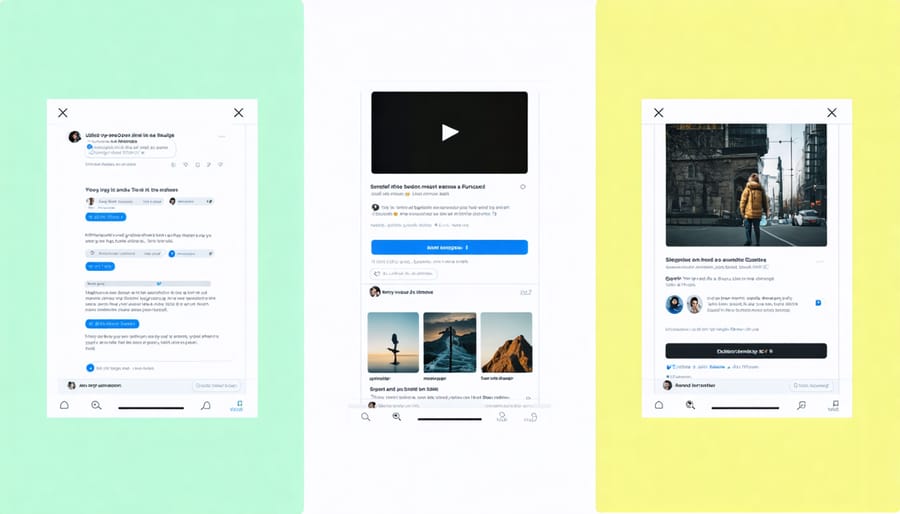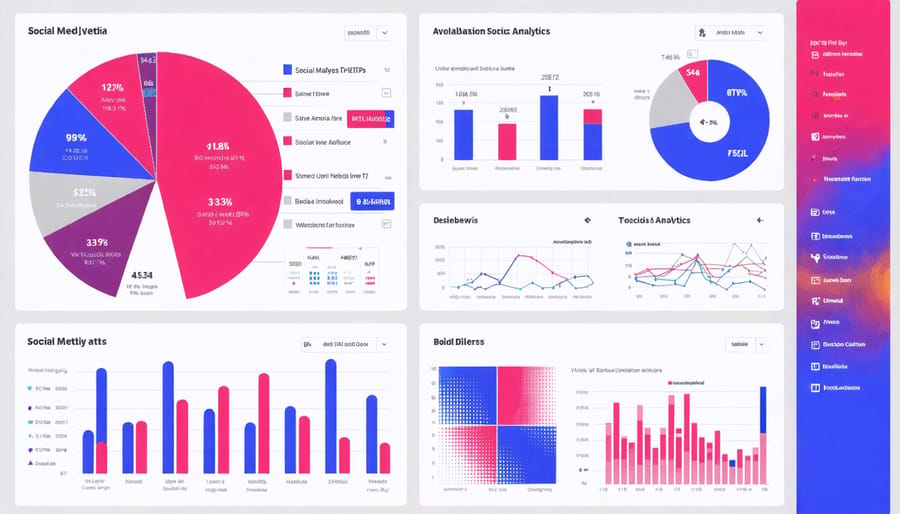Transform your tech startup’s social media presence by focusing exclusively on platforms where your target developers, IT decision-makers, and tech enthusiasts gather. Want to learn more? Visit this website.
Build authority through technical deep-dives on LinkedIn and Twitter, sharing code snippets, architecture decisions, and engineering challenges that showcase your startup’s innovation. Create bite-sized technical tutorials on Instagram and YouTube that solve specific developer pain points.
Leverage GitHub’s social features to build community around your open-source contributions while maintaining an active technical blog that demonstrates thought leadership. Cross-post content strategically, adapting the technical depth for each platform’s audience.
Establish a consistent posting schedule that aligns with your target audience’s peak engagement times – typically early mornings and lunch hours for tech professionals. Track metrics that matter: engagement on technical content, developer community growth, and conversion to product trials or signups.
Building Your Tech Brand’s Social Media Foundation

Choosing the Right Platforms
For tech entrepreneurs, not every social media platform will deliver the same value. LinkedIn stands out as your primary platform, offering direct access to industry professionals, potential investors, and B2B customers. It’s perfect for sharing technical insights and company updates.
Twitter (now X) is your second must-have platform, where tech discussions happen in real-time. Many tech influencers and developers actively engage here, making it ideal for joining relevant conversations and showcasing your expertise.
GitHub, while not traditionally considered social media, is crucial for tech founders. Your activity and contributions here can build credibility in the developer community.
Instagram and YouTube work well if your tech product has strong visual elements or requires detailed explanations. Instagram Stories and Reels can humanize your brand, while YouTube is perfect for product demos and tutorials.
Facebook might be less important unless you’re targeting small business owners or running paid ads. TikTok is worth considering only if your product appeals to younger audiences or if you can create engaging, tech-focused short-form content.
Remember: it’s better to maintain a strong presence on 2-3 platforms than to spread yourself too thin across all of them.
Creating Your Content Strategy
Creating a winning content strategy for tech audiences starts with a balanced mix of educational and promotional content. Aim for the 80/20 rule: 80% valuable insights and 20% product or service promotion. Share coding tips, industry trends, and tech updates that your audience will find genuinely helpful.
Break your content into three main categories: technical insights, behind-the-scenes glimpses, and thought leadership pieces. For technical content, share quick code snippets, tool recommendations, or problem-solving tips. Behind-the-scenes posts might showcase your team’s development process or workspace culture. Thought leadership can include your predictions about emerging technologies or lessons learned from your startup journey.
Use visual content strategically – screenshots, infographics, and short demo videos typically perform well with tech audiences. Consider creating a content calendar that includes:
– Monday: Technical tips
– Wednesday: Industry news and insights
– Friday: Team updates or project showcases
Remember to adapt your content based on platform preferences. LinkedIn users appreciate detailed technical discussions, while Twitter works better for quick tips and updates. Test different content types and posting times, then adjust based on your audience’s engagement patterns.
Content That Converts Tech Audiences
Technical Showcase Posts
When sharing technical achievements on social media, focus on creating engaging technical content that resonates with both tech-savvy followers and general audiences. Break down complex features into bite-sized highlights using simple analogies and visual aids. For example, instead of diving into code specifics, showcase the end-user benefits with before-and-after comparisons.
Use the 80/20 rule: 80% of your technical posts should focus on the problem you’re solving and its impact, while 20% can delve into the technical details. Create short video demos under 60 seconds, highlighting key features with clear annotations. Consider using carousel posts to walk through technical processes step-by-step.
Remember to humanize your technical posts by sharing the story behind the innovation. What inspired the solution? What challenges did your team overcome? This approach helps build connections with your audience while maintaining technical credibility.
Pro tip: Use platform-specific features like LinkedIn’s document sharing for detailed technical write-ups or Instagram’s Reels for quick technical tutorials. This maximizes engagement while keeping your content accessible and shareable.
Behind-the-Scenes Content
Behind-the-scenes content gives your audience an authentic glimpse into your startup’s world. Start by sharing your technical development processes through short video clips or photo series. Show your team brainstorming, debugging sessions, or product testing – these real moments help humanize your brand.
Document your company culture through Instagram Stories or LinkedIn posts. Share team lunches, casual Friday activities, or remote work setups. This transparency builds trust and shows potential customers and talent what it’s like to be part of your organization.
Create quick time-lapse videos of your product development stages or screenshot series showing interface evolution. These posts typically get high engagement because they satisfy people’s natural curiosity about how things are made.
Remember to highlight team achievements and milestones, but keep it genuine. Instead of polished corporate announcements, opt for candid celebration photos or brief team member spotlights. This approach makes your content more relatable and encourages meaningful connections with your audience.

Educational Content
Educational content is a powerful way to build authority and engage your tech-savvy audience on social media. Start by identifying the key challenges your target users face when learning new technology effectively. Create content that addresses these pain points through tutorials, how-to guides, and practical tips.
Mix different content formats to cater to various learning styles. Short video demonstrations can explain complex features, while infographics can break down technical concepts into digestible chunks. Written posts can dive deeper into specific topics, offering detailed explanations and step-by-step instructions.
Focus on solving real problems your audience encounters. For example, if you’re developing a coding platform, share debugging tips, coding best practices, or explanations of common error messages. Keep your content bite-sized and actionable – followers should be able to implement what they’ve learned immediately.
Remember to maintain a consistent posting schedule and encourage discussion. Ask questions, respond to comments, and create polls to understand what topics interest your audience most. This interaction not only boost engagement but also provides valuable insights for future content creation.
Consider creating themed series or weekly segments, like “Tech Tip Tuesday” or “Framework Friday,” to build anticipation and regular engagement with your educational content.
Growth Tactics for Tech Startups
Community Building
Building a thriving tech community on social media isn’t just about posting content – it’s about creating genuine connections and fostering meaningful discussions. Start by identifying your niche within the tech space, whether it’s AI, mobile apps, or cloud solutions, and connect with others in that specific area.
Engage authentically by sharing your journey, including both successes and challenges. Tech entrepreneurs appreciate honesty and real experiences over polished marketing speak. Comment thoughtfully on others’ posts, ask questions, and participate in relevant Twitter spaces or LinkedIn groups.
Create regular touchpoints with your community through:
– Weekly AMAs (Ask Me Anything) sessions
– Tech tip Tuesday posts
– Behind-the-scenes looks at your development process
– Quick polls about industry trends
– Live coding sessions or product demos
Remember to highlight your community members too. Share their wins, feature guest posts from community experts, and create opportunities for peer-to-peer learning. This builds stronger bonds and encourages active participation.
Don’t forget to establish community guidelines that promote constructive discussions and maintain a welcoming environment. Address technical questions promptly and encourage community members to help each other out.
Measure community health through engagement metrics, but focus more on quality interactions than pure numbers. A smaller, highly engaged community often provides more value than a large, passive following.
Collaboration Strategies
Success in tech entrepreneurship often comes down to who you know and how well you work together. Building strong partnerships and influencer relationships can dramatically boost your social media presence and reach.
Start by identifying potential collaborators who share your target audience but aren’t direct competitors. For example, if you’re developing a project management tool, partner with productivity coaches or workplace consultants. Create joint content, such as live streams or webinars, that provides value to both audiences.
Influencer partnerships work best when they’re authentic and tech-focused. Instead of chasing celebrities, connect with respected tech voices who understand your product. Consider micro-influencers in your specific niche – they often have higher engagement rates and more dedicated followers.
Here’s a simple approach to start collaborating:
1. Make a list of 5-10 potential partners in your space
2. Engage with their content regularly
3. Reach out with a specific, mutually beneficial proposal
4. Start small with guest posts or social media takeovers
5. Track results and scale what works
Remember to maintain transparency about partnerships and always prioritize value for your audience. The best collaborations feel natural and helpful rather than purely promotional.
Pro tip: Use tools like LinkedIn to find and connect with potential partners, and always follow up on successful collaborations with data-driven results to build long-term relationships.

Analytics and Optimization
To make data-driven decisions about your social media strategy, you’ll need to regularly monitor and analyze your performance metrics. Start by focusing on key metrics like engagement rates, click-through rates, and conversion rates specific to your tech product or service.
Most social media platforms offer built-in analytics, but you might want to explore specialized data analytics tools for deeper insights. Tools like Google Analytics, Hootsuite Analytics, or Sprout Social can help you track how social media traffic converts into actual product users or customers.
Here’s a simple process to optimize your social media performance:
1. Track post timing: Monitor when your tech-savvy audience is most active and schedule posts accordingly
2. Test content types: Compare engagement between product demos, tech tips, and behind-the-scenes content
3. Measure audience growth: Watch how your follower count changes after specific campaigns or product launches
4. Monitor competitor performance: Keep an eye on what works for similar tech companies in your space
Remember to A/B test different approaches: Try varying your post formats, headlines, and call-to-actions. Keep what works and improve what doesn’t. Set monthly review sessions to analyze your data and adjust your strategy based on concrete evidence rather than hunches.
Pro tip: Create a simple dashboard to track your most important metrics in one place. This makes it easier to spot trends and make quick adjustments to your strategy.
Common Pitfalls to Avoid
Even the most seasoned tech entrepreneurs can stumble on social media. Let’s look at some common mistakes to avoid so you can steer clear of these pitfalls and build a stronger online presence.
First up is the “all tech, all the time” syndrome. While your expertise is valuable, bombarding followers with nothing but technical content can be overwhelming. Mix in some behind-the-scenes glimpses, team stories, and personal insights to humanize your brand.
Another frequent mistake is inconsistent posting. Many tech entrepreneurs post intensively during product launches but go silent during development phases. Create a sustainable posting schedule that maintains engagement even during quieter periods.
Watch out for the automation overload trap. Yes, scheduling tools are helpful, but don’t automate everything. Your audience can tell when they’re getting canned responses or purely automated content. Keep real human interaction at the core of your strategy.
Many tech founders also fall into the “feature dump” pattern, focusing solely on product specifications rather than benefits and solutions. Remember, most followers care more about how your technology solves their problems than its technical specifications.
Ignoring community engagement is another critical mistake. Don’t just broadcast – participate in conversations, respond to comments, and actively engage with your community. Social media is a two-way street, not a megaphone.
The “perfect polish” paralysis can be particularly problematic in tech circles. While professionalism matters, obsessing over perfect posts can lead to minimal content output. Sometimes, authentic, timely content beats perfect presentation.
Finally, avoid the temptation to jump on every new social media trend or platform. Focus on channels where your target audience actually spends time and trends that genuinely align with your brand and message.
By being aware of these common pitfalls, you can develop a more effective social media strategy that genuinely connects with your audience while supporting your business goals.
Congratulations! You’re now equipped with the essential strategies to build a strong social media presence for your tech startup. Remember, success on social media isn’t about being everywhere at once – it’s about being strategic and authentic where your audience spends their time.
Start by picking one or two platforms that best match your target audience. Focus on creating valuable, tech-focused content that showcases your expertise while keeping things approachable and engaging. Don’t forget to measure your results using analytics tools and adjust your strategy based on what works.
The key is consistency and authenticity. Share your startup journey, celebrate your wins, learn from setbacks, and always keep your audience’s needs in mind. Build genuine connections by engaging with your community regularly and providing real value through your content.
Ready to get started? Begin by auditing your current social media presence, setting clear goals, and creating a content calendar for the next month. Remember, building a strong social media presence takes time, but the relationships and opportunities it creates are worth the investment.
